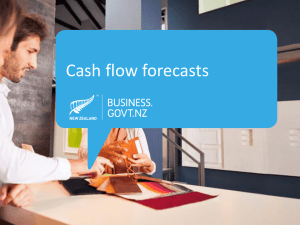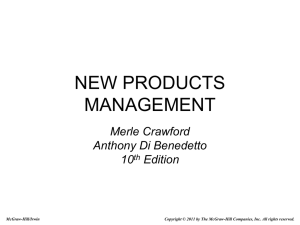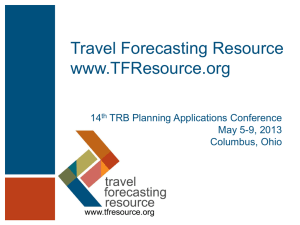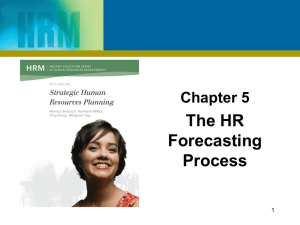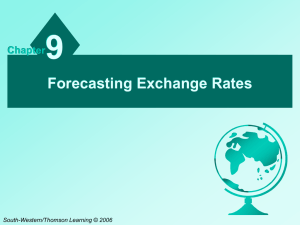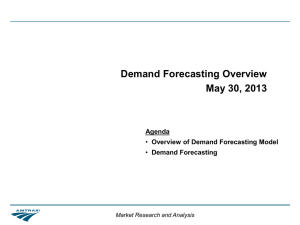F t+1
advertisement
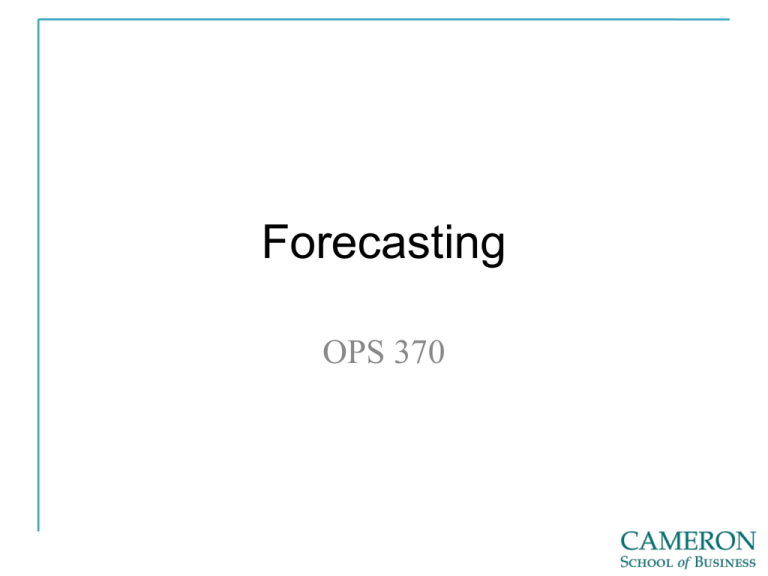
Forecasting OPS 370 Forecasting • What is Forecasting? – Determining Future Events Based on Historical Facts and Data • Some Thoughts on Forecasts – Forecasts Tend to Be Wrong! – Forecasts Can Be Biased! (Marketing, Sales, etc.) – Forecasts Tend to Be Better for Near Future • So, Why Forecast? – Better to Have “Educated Guess” About Future Than to Not Forecast At All! 2 Forecasting - Chapter 4 What to Forecast? Demand for Individual Products & Services Short Term (0-3 Months) Demand for Product & Service Families Medium Term (3 Months – 2 Years) Total Sales, New Offerings Long Term (>2 Years) 3 Forecasting - Chapter 4 How to Forecast? • Qualitative Methods – Based On Educated Opinion & Judgment (Subjective) – Particularly Useful When Lacking Numerical Data (Example: Design and Introduction Phases of a Product’s Life Cycle) • Quantitative Methods – Based On Data (Objective) 4 Forecasting - Chapter 4 Qualitative Methods • Executive Judgment • Sales Force Composite • Market Research/Survey • Delphi Method 5 Forecasting - Chapter 4 Quantitative Methods • Time Series & Regression • Time Series Popular Forecasting Approach in Operations Management • Assumption: – “Patterns” That Occurred in the Past Will Continue to Occur In the Future • Patterns – – – – 6 Random Variation Trend Seasonality Composite Forecasting - Chapter 4 Monthly Champagne Sales 1600 1400 1200 1000 800 600 400 200 0 0 12 24 36 48 Time (t) 60 72 84 UK Airline Miles U.K. Airline Miles U.K. Airline Miles Observe: 16000 Increasing trend, Seasonal component. 14000 Random variation. 12000 10000 8000 6000 4000 2000 Month 94 91 88 85 82 79 76 73 70 67 64 61 58 55 52 49 46 43 40 37 34 31 28 25 22 19 16 13 10 7 4 0 1 Thousands Thousands ofof MilesMiles 18000 Forecasting Steps Data Collection Data Analysis Collect Relevant/Reliable Data Be Aware of “Garbage-In, Garbage Out” Model Selection Monitoring 9 Forecasting - Chapter 4 Forecasting Steps Data Collection Data Analysis Plot the Data Identify Patterns Model Selection Monitoring 10 Forecasting - Chapter 4 Forecasting Steps Data Collection Choose Model Appropriate for Data Data Analysis Consider Complexity Trade-Offs Perform Forecast(s) Model Selection Select Model Based on Performance Measure(s) Monitoring 11 Forecasting - Chapter 4 Forecasting Steps Data Collection Data Analysis Track Forecast Performance (Conditions May and Often Do Change) Model Selection Monitoring 12 Forecasting - Chapter 4 Time Series Models • Short Term – Naïve – Simple Moving Average – Weighted Moving Average – Exponential Smoothing 13 Forecasting - Chapter 4 Forecasting Example • L&F Bakery has been forecasting by “gut feel.” They would like to use a formal (i.e., quantitative) forecasting technique. 14 Forecasting - Chapter 4 Forecasting Methods • Naïve • Forecast for July = Actual for June • Ft+1 = At • FJul = AJun = 600 • Forecast Very Sensitive to Demand Changes; Good for stable demand 15 Forecasting - Chapter 4 Forecasting Methods • Naïve (Excel) =C4 =C5 16 Forecasting - Chapter 4 Forecasting Methods • Moving Average • Forecast for July = Average of June, May, and April • Ft+1 = (At+At-1+…)/n • FJul = (600+500+400)/3 = 500 • Values Equally Weighted; Good for stable demand; Sensitive to fluctuation; Lags • Common application: Stock price forecasting Forecasting Methods 30 Day Moving Average of AAPL Price Forecasting Methods • Moving Average (Excel) =AVERAGE(C4:C6) = AVERAGE(C5:C7) Forecasting Methods • Moving Average Example • Assume n = 2 Week 1 2 3 4 5 Demand 125 175 150 (125+175)/2 = 150 150 (175+150)/2 = 162.5 160 (150+150)/2 = 150 (150+160)/2 = 155 Forecasting Methods • Weighted Moving Average • Ft+1 = (W1At+W2At-1+…) • Assume that W1 = 0.5, W2 =0.3 and W3 = 0.2 • FJul = (0.5)(600) + (0.3)(500) + (0.2)(400) = 300 + 150 + 80 = 530 • Typically Gives More Weight to Newer Data • Lags; Sensitive Forecasting Methods • Weighted Moving Average =$G$6*C6+$G$5*C5+$G$4*C4 =$G$6*C7+$G$5*C6+$G$4*C5 Forecasting Methods • Weighted Moving Average Example • Assume n = 2, W1 = 0.7, W2 = 0.3 Week 1 2 3 4 5 Demand 125 175 150 (0.7)(175) + (0.3)(125) = 160 150 (0.7)(150) + (0.3)(175) = 157.5 160 (0.7)(150) + (0.3)(150) = 150 (0.7)(160) + (0.3)(150) = 157 Forecasting Methods • Exponential Smoothing • Forecast for June = Forecast for May + a(Forecast Error in May) • a is a constant between 0 and 1 • Forecast Error = Difference Actual Demand and Forecasted Demand • General Formula: Ft+1 = Ft + aet Forecasting Methods • Exponential Smoothing • Assume that a = 0.3 • What is the forecast for July? • = June Forecast + a(Forecast Error in June) = 343 + (0.3)(257) = 420 • Requires less data; Good for stable data Month Jan (1) Feb (2) Mar (3) Apr (4) May (5) Jun (6) Jul (7) Actual 200 300 200 400 500 600 - Forecast 200 200 230 221 275 343 - Error 0 100 -30 179 225 257 - Forecasting Methods • Exponential Smoothing (Excel) Initial forecast =D4+$G$4*(C4-D4) =D5+$G$4*(C5-D5) Forecasting Methods • Exponential Smoothing Example • Assume a = 0.4 Week Demand 1 125 Need initial forecast; Assume 125 2 175 (125) + (0.4)(125-125) = 125 3 150 (125) + (0.4)(175-125) = 145 4 150 (145) + (0.4)(150-145) = 147 5 160 (147) + (0.4)(150-147) = 148.2 (148.2) + (0.4)(160-148.2) = 152.9 Forecasting Methods • How to Select Value of a? • Alpha determine importance of recent forecast results in new forecasts • Small alpha Less importance on recent results (Good for products with stable demand) • Large alpha Recent forecast results more important (Good for product with varying demands) Determining Forecast Quality • How Well Did a Forecast Perform? • Determine Forecast Error Error = Actual Demand – Forecasted Demand Month Jan Feb Mar Apr May Jun Actual 200 300 200 400 500 600 Forecast 200 200 230 221 275 343 Error 0 100 -30 179 225 257 Average Error 121.8 Determining Forecast Quality • Why is Average Error a Deceiving Measure of Quality? n • Better Measures: e Mean Absolute Deviation MAD t 1 n n 2 e t Mean Squared Error MSE Root Mean Squared Error RMSE = MSE 1 n Determining Forecast Quality Measure of Bias: Tracking Signal = Sum of Errors/MAD =731/131.8 = 5.55 *OK if between -4 and +4 MAD MSE Determining Forecast Quality For this MA(2) forecast. What is MAD, MSE, and TS? Week 1 2 3 4 5 Demand Forecast 125 -175 -150 150 150 162.5 160 150 155 Linear Regression • <SKIP Section in Textbook on Exponential Smoothing with Linear Trend> • Linear Regression Statistical technique that expresses the forecast variable as a linear function of one or more independent variables • Commonly Used for Causal Data – Example: Relationship Between Temperature and Ice Cream Sales • Also Used for Time Series Data (x Variable is Time, y is Demand, Sales, etc.) Linear Trend Line • Given Data – Y = Values of Response Variable – X = Values of Independent Variable • Parameters to estimate – a = Y-intercept Y a bX – b = slope • Use “least squares” regression equations to estimate a and b. – Or … Excel for Linear Regression Use SLOPE Function Use INTERCEPT Function
